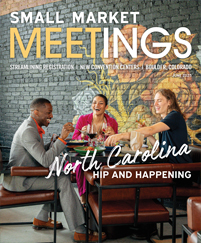
A trip to Fairbanks, Alaska, in the wintertime? Probably not at the top — or maybe even on — Shermonta Grant’s must-do list.
Yet, there she was in March, standing in the dark and the cold, chin lifted toward the heavens, taking in the eerie day-glow green of the aurora borealis; at her elbow were members of the American Geophysical Union explaining the phenomenon to Grant, who had planned the AGU’s conference in Alaska’s second-largest city.
Looking back on the evening, Grant forgot for a minute the bitter cold that kept her indoors during most of her stay. “It was,” she said, “definitely a remarkable experience.”
Extremes make Alaska interior extraordinary
The northern lights are only part of what makes the Alaska interior extraordinary to those from from the Outside (Alaskan shorthand for the Lower 48). Fairbanks is a land of extremes. Its summer days stretch long; its winter light is scant. Visitors who pack down coats quickly shed them in the summer, when temperatures climb to the 80s, but they are thankful for whatever warmth they can wrap around themselves in the winter, when the temperature can nosedive as much as 50 degrees in a day.
Winter’s edges best for meetings
September and March are the best times for meetings — summers are stuffed with leisure travelers, including those on land tours from cruise ships.
Helen Renfrew, director of meetings and conventions for the Fairbanks Convention and Visitors Bureau, looks at the draws, not the drawbacks, to meetings in the winter months. She and her staff think strategically, realizing that being 120 miles south of the Arctic Circle is a gold mine for those who study physical sciences.
“Anyone who studies earthquakes should meet in Fairbanks [there are earthquakes — imperceptible — every day],” said Renfrew. “Anyone who studies volcanoes, anyone who studies the northern lights, anyone interested in permafrost or in energy-efficient home building, those who work in timber, oil and gas [industries].”
By working with the University of Alaska (UA) Fairbanks, Renfrew and her staff have booked groups interested in those areas and others. The AGU’s recent conference is one such success. Meetings tied to UA now represent Fairbanks’ second-largest meeting niche, behind state associations, according to Renfrew.
In-state groups don’t worry about issues that make Outsiders fret, such as transportation.
“There is no difficulty flying into Fairbanks,” Renfrew said. Nor do they worry about whether businesses will be boarded up in the dead of winter. “We are open year round,” she said. “I think that is one of the biggest misconceptions.”
And, of course, the cold is a big concern. “The chilly temps only happen every so often,” said Renfrew. “It is not 40 below from December to February.”
On the bright side, groups can do things in Fairbanks that few back home have done. They can drink martinis in glasses carved from ice, take a flight over the Arctic Circle, or meet a dog-sledding team and go mushing across the tundra; and, especially in the wintertime, when skies stay dark nearly all day, there’s a good chance visitors will see the northern lights. Japanese tourists, a mainstay in winter, go on four-day tours.
“There’s a greater-than-70 percent chance they will see the lights,” said Renfrew.
Because Fairbanks is small (population 36,000; 90,000 if the surrounding borough is included), the city is suited for groups of 400 or fewer, although it can accommodate larger gatherings. For example, the International Arctic Winter Games, will be held in Fairbanks in 2014 for the first time in 25 years.
Compared with the state’s largest city, Fairbanks is a more authentic experience, Renfrew said.
“The folks who come to Fairbanks are looking for more of an Alaskan experience. Anchorage is comparable to other cities in the lower 48.”
Four hotels dominate
Larger groups make use of the arena and 10,000 square feet of meeting space at the Carlson Center or the 15,000 square feet of space at the Alaska Centennial Center for the Arts in Pioneer Park, which also has a 384-seat theater.
Four hotels handle most of the convention trade: the Westmark Fairbanks Hotel, the city’s largest, with 400 guest rooms and 16,000 square feet of meeting space, a dozen blocks from downtown; the Fairbanks Princess Riverside Lodge, with 325 guest rooms and 9,000 square feet of meeting space, five miles from downtown on the Chena River; and the Pike’s Waterfront, with 208 guest rooms and 7,000 square feet of meeting space, also on the river.
Five minutes from downtown is the 130-acre Wedgewood Resort, a complex that includes a lodge with traditional guest rooms, another lodge with one- and two-bedrooms suites, an award-winning antique auto museum (see sidebar, p. 16) and 9,200 square feet of meeting space.
Guest rooms in its Bear Lodge are open only in the summer but can be booked in the wintertime for meetings and conventions.
The resort backs up to a wildlife refuge and has its own wildlife sanctuary with interpretive trails linked to those in the refuge.
When it bought the 100 acres for the wildlife sanctuary, the resort also added a meeting facility, the 2,600-square-foot Taiga Center.
“It is literally built into the boreal forest,” said the resort’s Diane Shoemaker. “When you take a 10–minute break, you are at the trailhead for all of these trails.
No lack of action in the Arctic
Of course, snowshoeing might be more in step in March. But locals attest that winter visitors won’t lack for activities.
“They are so worried about cabin fever here that we have four theater companies [and] three dance companies; there is a richness of culture that you would not expect of a town of this size this far north,” said Lloyd Huskey of the university’s Museum of the North (see sidebar, p. 16).
Entertainment is also a bargain. Entertainers and musicians often overnight in Fairbanks before they depart on international tours. “We get concerts here that Seattle can’t even get, because Fairbanks is often a stop on the way to Europe,” said Renfrew. Shows that might cost $200 per person in larger cities are under $40 in Fairbanks.
One of the most popular day trips for meeting groups is Chena Hot Springs Resort, about an hour from town on a paved road. There, the mineral springs that spawned the original resort in 1905 are just the tip of the iceberg.
Although the 40-room resort has meeting space, many groups that meet in Fairbanks go there for the day. They learn about renewable energy, sip cocktails in a museum carved from ice and unwind in the 105-degree mineral waters of the resort’s outdoor rock lake.
No chemicals are added, so the lake is drained and cleaned once each week to prevent bacteria or other problems. Only those 18 and over are allowed to use the lake.
The large boulders that edge the lake, topped with snow in the winter, serve more than an aesthetic purpose.
“They are there to keep the moose out, because moose like a dip in a warm pond, too,” said Denise Ferree, director of marketing and sales.
Before or after swims, groups can adjourn to the resort’s ice museum for an appletini served in martini glasses carved from ice by a couple who teach ice sculpture classes at the resort.
The ice glasses are unusual souvenirs; one savvy guest from Fairbanks who arrived armed with dry ice managed to take hers home and used it for seven more drinks before it became a puddle.
Depending on the season, receptions in the ice museum might have a time limit. “When you get a lot of body heat in there, it starts to melt,” said Ferree.
The ice museum has been frozen solid since 2004, when resort owner Bernie Carl collaborated with an Atlanta inventor who devised a way to keep it frozen year round by using the hot springs. The system is the only one of its kind in the world, said Ferree.
The luckiest guests get owner Carl as their guide. A Midwesterner who grew up as one of 16, Carl isn’t joking when he says recycling is a concept to which he was exposed at an early age.
He and his brother were in the recycling business 30 years; after he bought the resort in 1998, he took it off the power grid, developing a system that powers the resort by using the springs.
That system also powers a greenhouse where salad greens, herbs and tomatoes are grown year round. Both systems are on the resort’s renewable energy tour.
Because it is not affected by light pollution, Chena Hot Springs is a good viewing spot for the aurora borealis; snow coaches carry visitors to the tops of hills for better and warmer views.
“My best memory is being in the pond at the end of February with a group of travel agents when the aurora came out,” Ferree said. “There you are, up to your neck in 105-degree water, and you see the beautiful aurora above your head.”
Many who come to Fairbanks from the Outside for a meeting incorporate a personal vacation. The blend of personal and professional can be a perfect way to see what Renfrew and other Alaskans realize is a special part of the world.
“There are people who save their entire lives to come and visit the state we call home,” Renfrew said.
More on Fairbanks:












